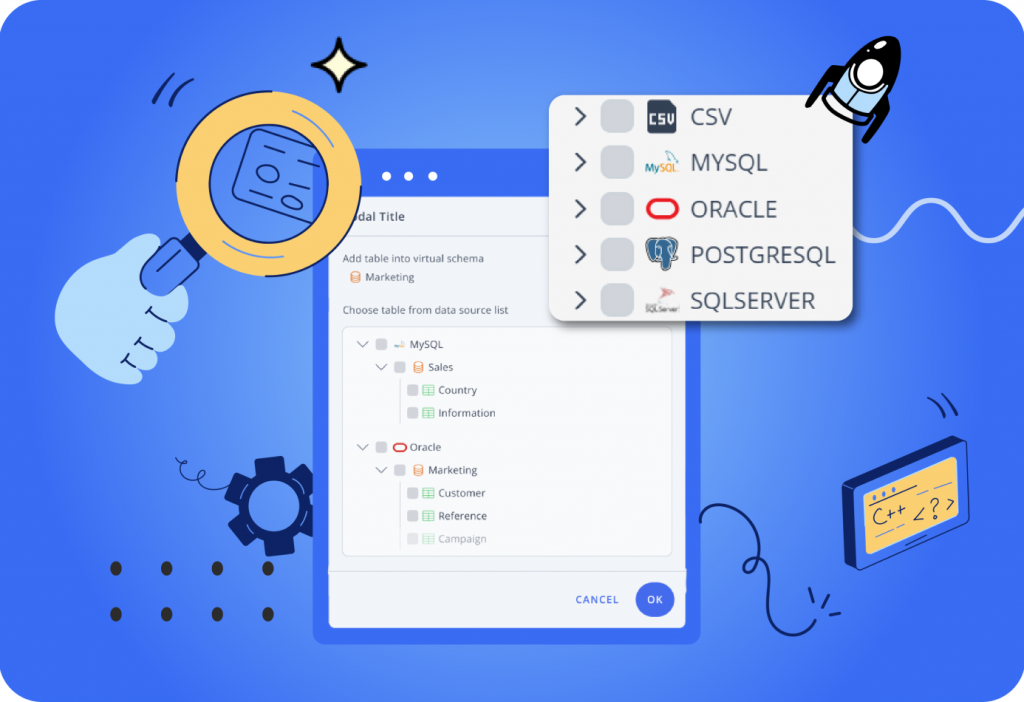Understanding Data Virtualization and Supported Sources

In the digital era, data has become a valuable asset for companies, but it is often scattered across various systems, formats, and platforms, making it difficult to manage. Virtualization offers a solution by enabling access and integration of data from multiple sources without the need for relocation or duplication. This technology creates an access layer that simplifies data management, allowing real-time analysis without altering the original sources. Use Case: Challenges Faced by Data Analysts in Data Integration A Data Analyst at a retail company is tasked with analyzing sales trends. The data needed comes from various sources: Before using virtualization, the team had to manually download and merge this data, which was time-consuming and prone to errors. With virtualization, the Data Analyst can access all this data in a unified view without relocating it, enabling faster and more efficient real-time analysis. Read Also : Supported data sources in Data Virtualization Supported Data Sources in Virtualization One of the key advantages of virtualization is its ability to connect with various data sources. Here are some of the data types that this technology can support: Diverse Data Sources Virtualization can connect various types of databases, both relational and non-relational, including: Various File Formats Besides databases, virtualization can also access and integrate data from different file formats, such as: Big Data Technologies In the world of big data, virtualization can connect with large-scale data processing technologies, such as: Benefits of Virtualization Faster Data Access: No need for physical data movement, which speeds up the analysis process. Cost Efficiency: Businesses can reduce the need to store data in separate systems, leading to significant savings. High Flexibility: This technology adapts well to various IT environments, whether on-premise or cloud-based. Enhanced Security: Since data remains in its original source, the risk of data breaches is minimized. Conclusion Virtualization is an effective solution for managing data from multiple sources without physically relocating it. With support for relational databases, NoSQL, file formats such as CSV and JSON, and big data technologies like Hadoop and Spark, virtualization offers high flexibility in data integration and analysis. This technology is an ideal choice for companies looking to improve data management efficiency in the digital era. If you want to optimize data management with virtualization technology, Dave is here to help! Try our service and experience seamless data access and integration on a single platform.
Understanding Data Virtualization: Revolutionizing Data Access and Integration

Introduction In today’s data-driven world, organizations are inundated with vast amounts of data from various sources. This data, often stored in disparate systems, can pose significant challenges for efficient access and integration. Enter data virtualization—a technology that offers a solution to these challenges by providing a unified view of data without the need for physical consolidation. What is Data Virtualization? Data virtualization is an advanced data management technology that allows users to access, manage, and manipulate data without requiring details about its physical location or format. Unlike traditional data integration methods, which involve physically moving and consolidating data into a central repository, data virtualization enables real-time data access and integration from multiple, heterogeneous sources. Key Benefits of Data Virtualization Real-Time Access to Data: Data virtualization provides real-time access to data from various sources, allowing for timely and informed decision-making. Cost Efficiency: By eliminating the need for data replication and consolidation, data virtualization reduces storage and processing costs. Improved Data Governance: Centralized data access and control enhance data governance and compliance with regulatory requirements. Agility and Flexibility: Organizations can quickly adapt to changing business needs and data sources without significant changes to the underlying infrastructure. Enhanced Data Security: Data virtualization enables secure data access and integration, ensuring that sensitive information is protected. How Does Data Virtualization Work? Data virtualization works by creating an abstraction layer between data consumers and the underlying data sources. This layer allows users to interact with data in a unified, logical manner, regardless of where the data physically resides. Here’s a step-by-step overview of how data virtualization functions: Data Source Connection: Connect to various data sources, such as databases, data warehouses, cloud services, and big data platforms. Metadata Management: Create and manage metadata that describes the structure, relationships, and semantics of the data. Data Integration: Use advanced data integration techniques to combine data from different sources into a unified view. Data Access: Provide real-time data access to users through a variety of interfaces, such as SQL, APIs, and BI tools. Data Security and Governance: Implement robust security measures and governance policies to ensure data integrity and compliance. Use Cases of Data Virtualization Business Intelligence and Analytics: Data virtualization enables seamless access to data from multiple sources, facilitating comprehensive and timely business intelligence and analytics. Customer 360 View: Create a unified view of customer data from various systems, enhancing customer insights and personalized experiences. Data Migration: Simplify data migration processes by providing real-time access to data across old and new systems during transition periods. Big Data Integration: Integrate and analyze data from big data platforms with traditional data sources without the need for complex data movement. Challenges and Considerations While data virtualization offers numerous benefits, it also comes with its own set of challenges and considerations: Performance: Ensuring optimal performance for real-time data access can be challenging, especially with large and complex data sets. Data Quality: Maintaining data quality and consistency across different sources is crucial for accurate analysis and decision-making. Complexity: Implementing and managing a data virtualization solution requires a certain level of expertise and can be complex. Cost: Although it can reduce some costs, data virtualization solutions themselves can be expensive to implement and maintain. Conclusion Data virtualization is revolutionizing the way organizations access and integrate data, offering a flexible, efficient, and cost-effective solution to traditional data integration challenges. By providing real-time, unified views of data from diverse sources, data virtualization empowers businesses to make better decisions, enhance operational efficiency, and stay competitive in the data-driven landscape. Embracing data virtualization can be a game-changer for your organization, providing the agility and insights needed to thrive in today’s fast-paced, information-rich environment. Call to Action Ready to explore the potential of data virtualization for your business? Contact us today to learn more about how our data virtualization solutions can help you achieve your data integration and management goals.
